Mastering the Art of Smoked Brisket Preparation
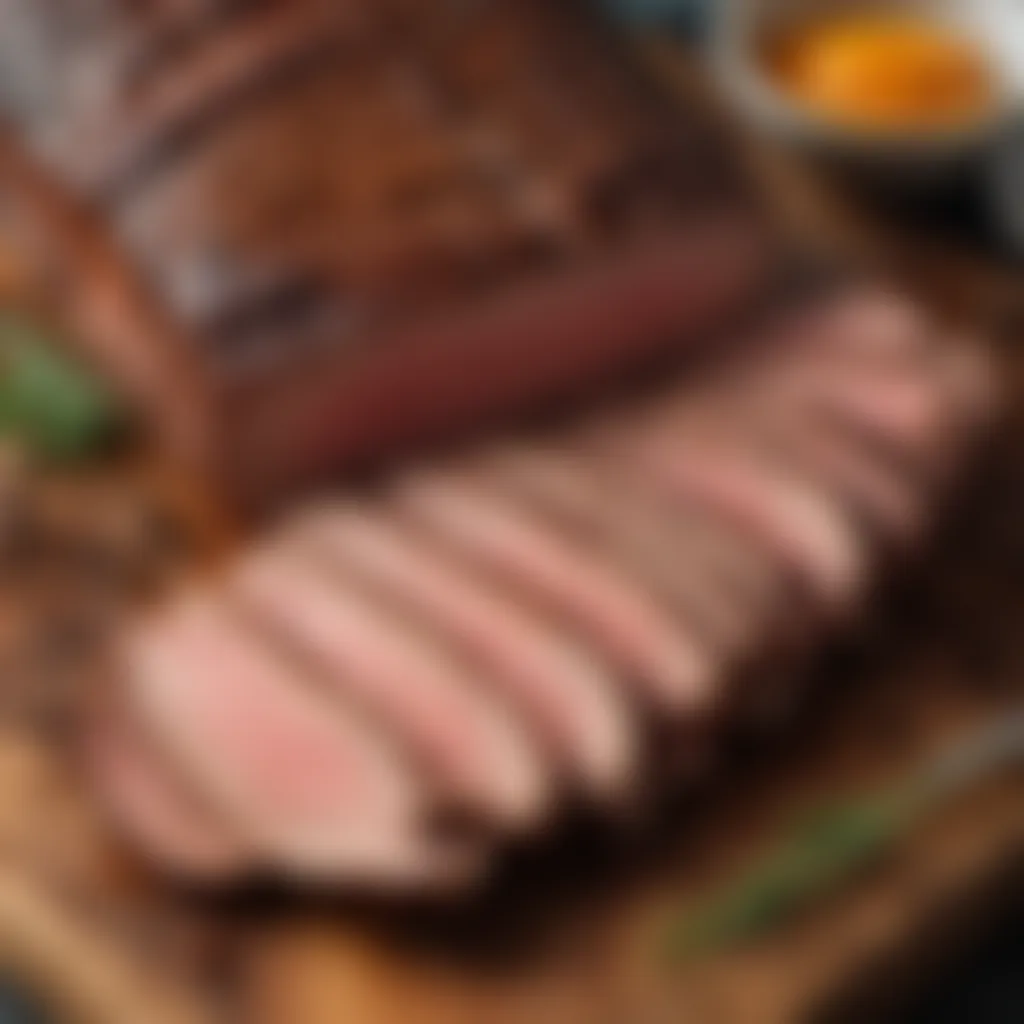
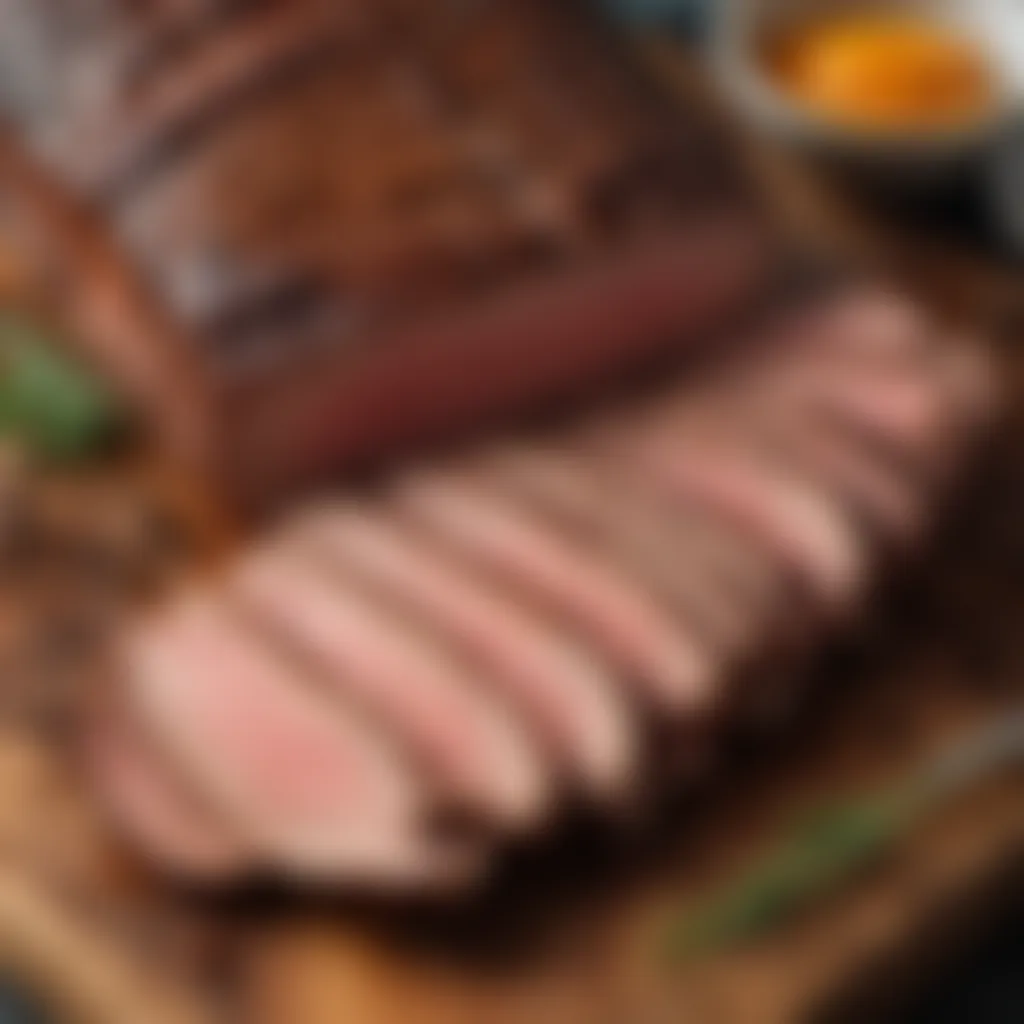
Intro
Creating the perfect smoked brisket is like composing a symphony; it takes time, practice, and a deft touch to master the blend of flavors and textures. Brisket has long been a mainstay in barbecues and cookouts, becoming a culinary tradition for many families. While it may seem daunting at first, even a novice cook can transform a humble cut of meat into a mouthwatering feast. This guide will help you navigate each step of the process with clarity, from gathering your ingredients to savoring the final product.
Ingredients:
Before diving headfirst into cooking, it's crucial to gather the right ingredients. Quality is paramount. Here’s what you’ll need:
- Brisket: 5-6 pounds (preferably packer brisket, which includes both the flat and point)
- Kosher salt: 1/4 cup
- Black pepper: 1/4 cup
- Garlic powder: 2 tablespoons
- Onion powder: 2 tablespoons
- Paprika: 2 tablespoons
- Brown sugar: 1 tablespoon
- Cayenne pepper: 1 teaspoon (optional, for a kick)
- Apple juice or beef broth: 1 cup (for spritzing)
- Wood chips: Hickory or mesquite (soaked in water for at least 30 minutes)
Preparation Steps:
- Trim the Brisket: Start by trimming excess fat from your brisket. Aim to leave about a quarter-inch of fat cap for flavor during cooking. A little fat goes a long way in keeping the meat moist.
- Prepare the Rub: In a mixing bowl, combine kosher salt, black pepper, garlic powder, onion powder, paprika, brown sugar, and cayenne pepper. Mix thoroughly to create your dry rub.
- Season the Brisket: Generously apply the rub over the entire surface of the brisket. Make sure to work it into every nook and cranny. For optimal flavor, wrap it tightly in plastic wrap and refrigerate for at least 12 hours, or ideally overnight.
Technical Aspects:
Achieving the perfect smoked brisket involves understanding temperature settings and timing. The key is to smoke it low and slow:
- Smoking Temperature: Maintain a consistent temperature between 225°F and 250°F.
- Cooking Time: Expect to cook the brisket for about 1 to 1.5 hours per pound. For a 6-pound brisket, this would mean approximately 6 to 9 hours.
- Internal Temperature: Your end goal is an internal temperature of at least 195°F to 205°F for optimal tenderness.
Cooking Process:
- Preheat Your Smoker: Prepare your smoker by preheating it to the desired temperature. Load it with your soaked wood chips to ensure a steady smoke.
- Place the Brisket on the Smoker: Once the smoker is stable, place the brisket fat-side up on the grates. This allows the fat to render down into the meat.
- Monitor the Brisket: It’s essential to monitor the internal temperature with a meat thermometer, checking every hour. If you notice a stall (the temperature holds steady), don’t fret. This is simply a part of the process.
- Spritzing: Every 2 hours, spritz the brisket with apple juice or beef broth to maintain moisture.
- Wrap the Brisket: Once the brisket reaches an internal temperature of around 160°F, wrap it in butcher paper or foil to help power through the stall and retain moisture.
- Finish Smoking: Allow the brisket to continue cooking until it reaches your target internal temperature of around 200°F for slicing tenderness.
Troubleshooting Tips:
Even experienced cooks can run into issues. Here are some common problems and how to handle them:
- Problem: The brisket is cooking too fast. Solution: Lower the temperature of your smoker or wrap the brisket sooner.
- Problem: Flat is dry. Solution: Ensure there’s enough fat left on the brisket and consider using a spritz more frequently.
- Problem: Stalling at a temperature. Solution: Be patient; this is normal. Wrapping the brisket can help push through this phase.
Important Note: Always allow your brisket to rest for at least 30 minutes after cooking. This helps the juices redistribute, making for a juicier slice every time.
With careful attention to these details, anyone can craft a divine smoked brisket worth celebrating. So roll up your sleeves, and let the smoke do its work!
Preface to Smoked Brisket
When we talk about smoked brisket, it’s not just about slapping some meat on a grill and calling it a day. It’s an intricate dance of flavors, textures, and techniques that demands both patience and understanding. This section sets the stage for exploring the world of smoked brisket, revealing why mastering this dish can turn an ordinary meal into a transcendent culinary experience.
Historical Context
Smoked brisket has roots that dig deep into various culinary traditions. In the United States, its connection with barbecue culture is especially notable. The brisket cut became popular post-World War II as smokehouses and barbecue joints began to rise in favor. For instance, in Texas, the smoked brisket has become a staple, enjoyed during family gatherings and local competitions. Its preparation often involves the use of traditional methods passed down through generations. However, brisket’s journey isn’t limited to one region; look across the globe, and you’ll find similar techniques woven into the fabric of many cultures. From Argentina’s asado to Jewish brisket traditions during holiday meals, the smoking of this cut embraces diverse flavors yet speaks a universal language.
Cultural Significance
Beyond its rich history, smoked brisket serves as a social centerpiece in many gatherings. In American culture, it’s not uncommon to find brisket at backyard barbecues, family reunions, or even tailgate parties. It draws folks together, igniting camaraderie and conversation. Moreover, the way families pass down their recipes, each adding personal twists, shows how brisket becomes a part of their cultural identity. You could say that brisket is more than food; it’s a way of life for many. People often bond over their skills or stories related to preparing this dish, creating an unspoken community spirit that can be felt across kitchens.
"The joy of shared meals brings warmth to relationships, and smoked brisket has that special ability to forge lasting connections."
Understanding Brisket
Understanding the brisket is absolute key in your journey to mastering smoked brisket. Brisket isn’t just any old cut of meat; it’s a culinary treasure with depth, tradition, and a whole lot of character. Not only is it known for its rich flavor, but also for the techniques behind cooking it. When you grasp the complexities of brisket, you’ll be better equipped to make it come alive on your smoker. Let’s dig a little deeper.
Anatomy of Brisket
Brisket comes from the lower chest area of the cow, and it’s made up of two main muscles: the pectoralis major and the pectoralis minor. These muscles do a lot of work because they support the weight of the cow. This constant movement means brisket is tough and needs gentle handling to break down those fibers. Think of it like a fine wine; it only gets better with time and careful treatment.
- The flat cut, also known as the first cut or the leaner part, is usually where you get those nice slices that are beautiful for serving.
- The point cut, more marbled and juicier, has rich flavor and is known to be trickier to slice due to its shape.
Each one contributes to the final dish in its own way, making them both valuable.
Understanding the anatomy of brisket not only affects your cooking experience, but it also enhances the flavor profile of your final dish.
Cuts of Brisket
Discussing cuts of brisket brings us to the heart of selecting your meat. Not all briskets are created equal, and knowing the differences in cuts can greatly influence your cooking.
- Whole brisket: This is the entire cut that includes both the flat and point. It’s perfect for those family gatherings or barbecue competitions.
- Point cut: A little more forgiving during cooking due to its fat content, it’s the go-to for those who want that moist flavor in their brisket sandwich.
- Flat cut: When you're aiming for a nice slice on your plate, the flat cut is what you need. It’s leaner and often best for those who favor a cleaner bite.
When purchasing brisket, it’s wise to consider how you plan to serve it. If you’re going for low and slow cooking, the point cut will likely yield the best results.
Remember to look for a good amount of marbling, as that’s where the flavor hides! This care in selection will pay off in culinary delight later on.
Understanding the brisket, its anatomy, and the nuances of different cuts not only lays the groundwork for a fantastic smoked brisket, it’ll also empower you to elevate your cooking game to the next level.
Selection of Ingredients
When it comes to transforming a simple cut of meat into a mouthwatering smoked brisket, the selection of ingredients plays an invaluable role. This phase sets the stage for what flavor profiles can emerge, and considering these elements thoughtfully can result in a dramatically different culinary experience. Good ingredients aren't just about taste; they can influence the texture and juiciness of the final product.
Choosing Quality Meat
The first step in your ingredient journey is identifying the right cut of brisket. Not all briskets are created equal. Look for cuts that have a good amount of marbling; those wavy lines of fat running through the muscle contribute to tenderness and flavor. The ideal brisket will be deep red, with a firm texture and little to no dark spots. When you run your fingers over the meat, it should feel both moist and somewhat tacky, an indication that it’s fresh.
Seek meat from trustworthy sources, farms known for ethical practices. Some cuts may be more available in your local butcher shop than others, but if you don’t find exactly what you’re looking for, don’t hesitate to ask for recommendations.
Choosing meat based solely on price might seem like a smart move, but it often leads to a disappointing result. Premium cuts, while they may cost a bit more upfront, will save you from a lackluster end product that calls for a second chance.
Essential Marinades and Rubs
Besides the meat itself, the marinades and rubs are where the magic truly begins. These are the flavor enhancers that can transform your brisket from ordinary to extraordinary. When concocting your marinade or rub, consider the balance of flavors. You want a mix of sweet, savory, and spicy to create layers of taste.
For marinades, start with a base of oil—olive oil or canola works well—and add an acidic component like apple cider vinegar or lemon juice. These acids help to tenderize the meat. Combine this with herbs, garlic, and spices to create a base that can truly penetrate the meat. Let your brisket marinate overnight for the flavors to meld well.
As for rubs, a simple mix of salt, black pepper, paprika, and a hint of cayenne pepper can create a pleasing crust on your meat. Feel free to experiment with additional spices like brown sugar for a touch of sweetness, or even coffee grounds for a complex, rich flavor that surprises the taste buds.
"The right seasoning can elevate each bite of brisket, making the experience memorable."
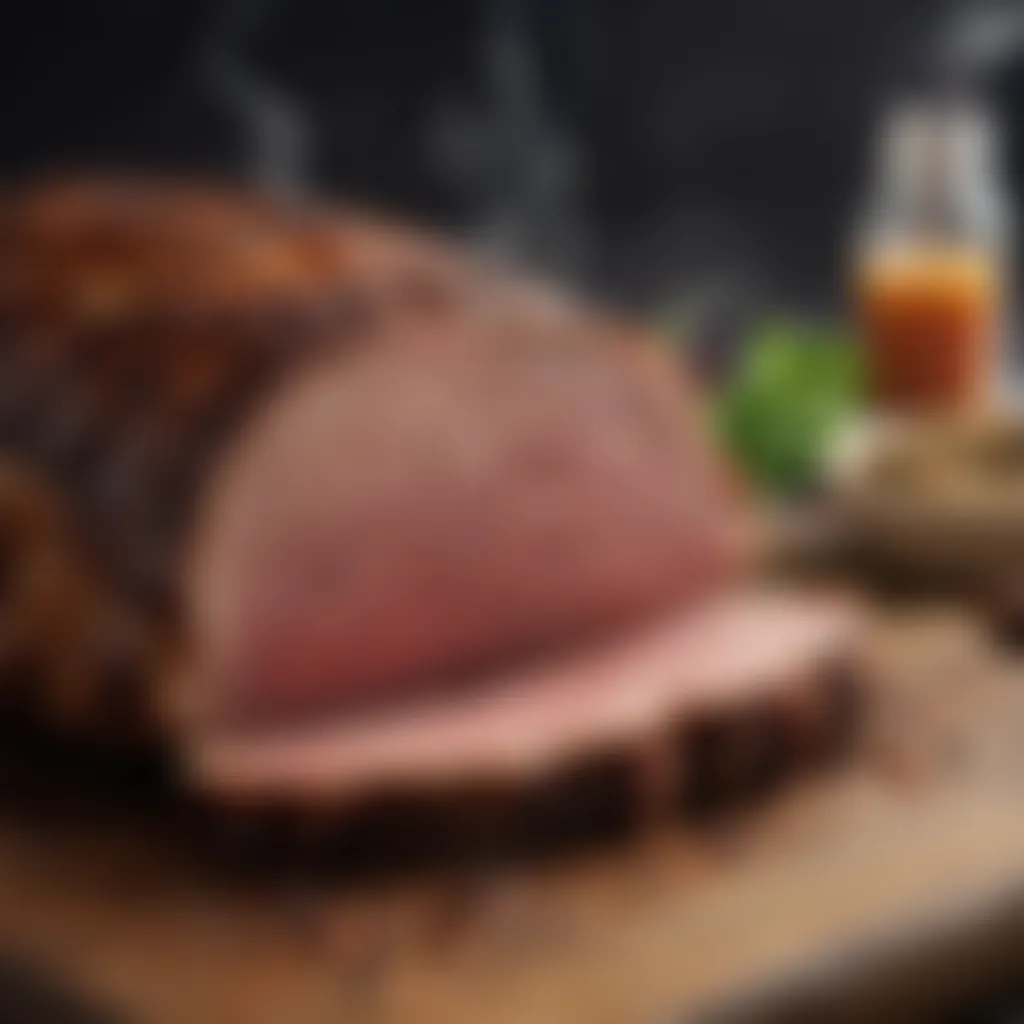
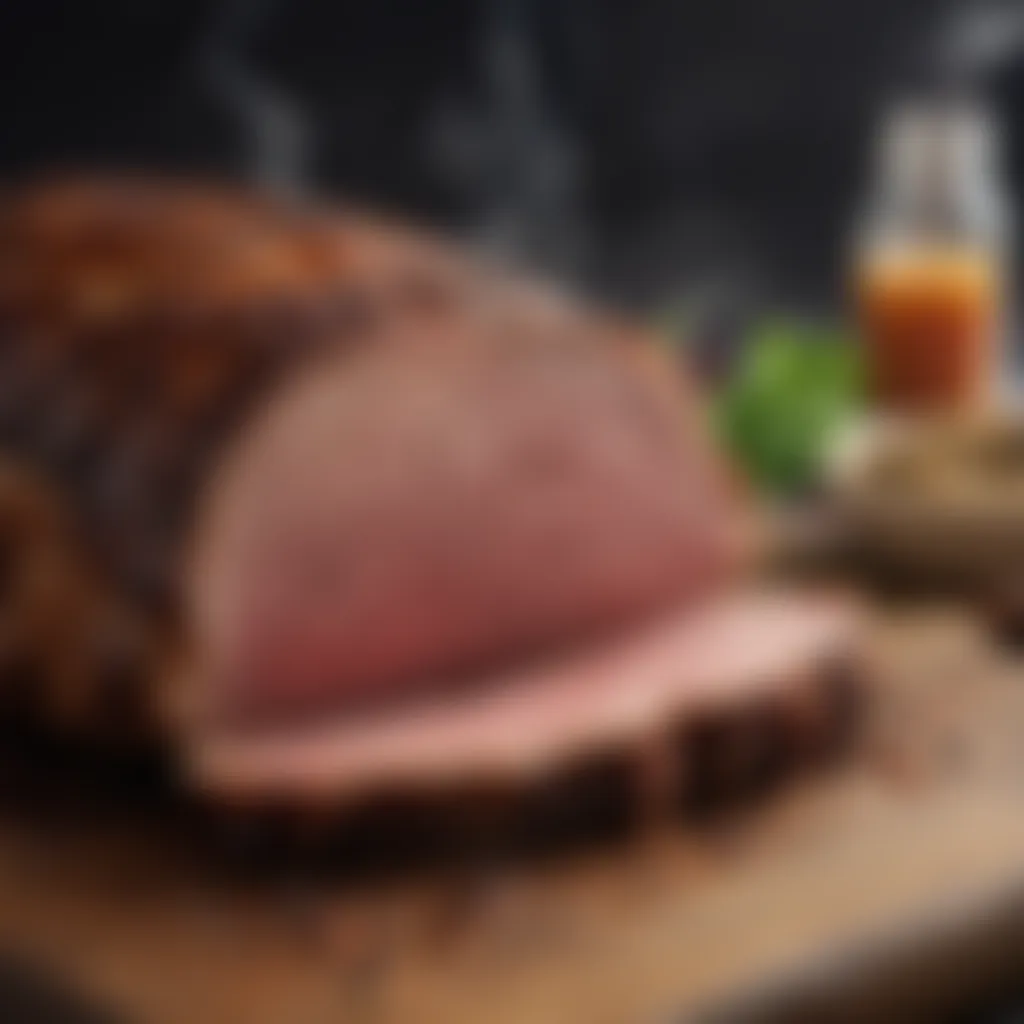
Once you've selected your brisket and prepared your rub or marinade, you're laying a firm foundation for your cooking adventure ahead. Each step in the selection of ingredients builds upon the last, ensuring that every bite of your smoked brisket is a delightful taste of satisfaction.
The Smoking Process
The journey to a perfectly smoked brisket is nothing short of an alchemical dance, where heat, time, and technique intertwine. The smoking process not only imbues the meat with complex flavors but also transforms its texture, an essential aspect of brisket's appeal. Mastery over this process can elevate a simple cut of meat into a culinary centerpiece.
Equipment and Tools
Having the right tools is crucial for any home cook looking to achieve that coveted smoked brisket. First and foremost, you need a reliable smoker. While there are various options available, including electric, pellet, and charcoal smokers, each comes with its own advantages and quirks.
Essential Equipment:
- Smoker: An offset smoker is favored by many for its ability to maintain consistent temperatures and provide that perfect smoky flavor.
- Thermometers: Investing in both a meat thermometer and a smoker thermometer helps in tracking internal and cooking temperatures without constant checking.
- Chopping Board: A sturdy board is needed for all that slicing post-cooking.
- Foil or Butcher Paper: To wrap the brisket during the final cooking stages, preventing it from drying out could take your result to the next level.
Having these basics can make the smoking process not just easier but more enjoyable. Remember, a bit of preparation goes a long way!
Types of Smokers
Diving deeper into smokers, it’s fascinating to see how the choice can influence the outcome. Here are some popular types:
- Charcoal Smokers: Many consider these the gold standard. They require more attention but reward you with a rich flavor that’s hard to beat.
- Electric Smokers: For those who prefer a set-and-forget method. While they lack the same depth of flavor, they can still deliver satisfactory results.
- Wood Pellet Smokers: They offer a nice middle ground, combining convenience with authentic wood flavor.
Each type of smoker indeed has its own loyal following, but it’s essential to choose based on your comfort level and preference.
Wood Selection
When it comes to smoking, wood selection isn’t just a matter of convenience; it’s one of the most significant decisions you make in the process. Different woods impart unique flavors to your brisket, and choosing the right one can enhance the overall eating experience dramatically.
Here are some popular choices:
- Hickory: Considered a classic, it adds a strong flavor that's sweet and smoky, great for beef.
- Oak: This wood offers a medium flavor that is versatile, providing a solid backbone without overshadowing the brisket's natural taste.
- Mesquite: Known for its bold profile, it should be used sparingly, as its intense flavor can overpower the meat if you’re not careful.
Experimenting with different woods can be a delightful, albeit a bit trial-and-error journey, but that's all part of crafting a divine smoked brisket. Make sure to source quality wood, as anything treated or artificially flavored can sabotage your efforts.
"The choice of wood is ultimately the crown jewel in your smoking process. Choose wisely."
In summary, the smoking process is a fundamental aspect that requires thoughtful consideration and execution. From choosing the appropriate equipment to the type of smoker and wood, every detail matters in crafting that divine smoked brisket.
Temperature Management
In the world of smoked brisket, temperature management stands as a cornerstone technique that can make or break your culinary efforts. Understanding how to control temperatures is not just a matter of routine—it's about achieving mouthwatering results. Proper temperature management ensures that your brisket cooks evenly, allowing the flavors to marry beautifully, and helping to break down the tough fibers for that melt-in-your-mouth texture that everyone craves. Additionally, the balance of temperature impacts not only the taste, but also the safety of the dish, making it a crucial aspect worth paying heed to.
Understanding Cooking Temperatures
When it comes down to cooking meat, especially something as robust as brisket, the right temperature can spell the difference between tender and tough. Smoking brisket generally requires a low and slow approach, typically between 225°F and 275°F. This range is often optimal for breaking down the connective tissues that transform into luscious collagen; this makes your brisket nearly dancing on your taste buds.
It’s essential to keep in mind that while lower temperatures allow for gentler cooking, they can also extend the overall cooking time. However, this patience usually pays off in flavor. The widely accepted rule of thumb is that you’ll want to smoke your brisket for about 1 to 1.5 hours per pound, but factors like the size of the meat and the type of smoker can affect this timing.
Some common cooking temperatures include:
- 200°F - 225°F: Ideal for slow smoking and tenderizing.
- 250°F - 275°F: A sweet spot for a good balance between cooking speed and tenderness.
- Above 300°F: This method can yield quicker results, but might not develop the ideal texture.
Monitoring Internal Temperatures
Having a firm grasp on internal temperatures is equally crucial. Relying on the pit temperature alone won't give you the full picture. Instead, investing in a reliable thermometer can make all the difference. One must monitor the internal temperature of the brisket to ensure it reaches about 195°F to 205°F for peak tenderness. This is where the magic truly happens—the moment the collagen breaks down, rendering your brisket beautifully juicy.
Utilizing a meat thermometer, sometimes referred to as a probe, is invaluable here. It’s wise to insert it into the thickest part of the brisket, away from the bone if there’s one, to ensure accurate readings.
The following are internal temperature checkpoints:
- 140°F: Where it starts to be safe to eat, but tough.
- 160°F: Considered the danger zone—it can dry out if overcooked here.
- 190°F: The ideal point where it’s still juicy and can start hitting that tenderness sweet spot.
- 205°F: This is the sought-after level where brisket truly shines, flaky and succulent.
Key Point: A well-cooked brisket won't be determined merely by external appearance but rather by careful monitoring of its internal state.
Techniques for Perfecting Flavor
When it comes to smoking brisket, flavor is the name of the game. Mastering the right techniques can transform your brisket from ordinary to unforgettable. Techniques such as brining or injection, alongside skilful application of rubs, allow the meat to absorb flavors deeply, enhancing that savory experience with each bite. It’s not just about seasoning; it’s about creating a dialogue between the meat and the flavors introduced through thoughtful preparation. With the right methods, you can expect your brisket to shine on any dining table.
Brining vs. Injection
Brining and injection are two distinct approaches to infusing flavor into brisket. Each has its merits, and understanding them is key to unlocking the full potential of your meat.
Brining is like giving your brisket a warm, flavorful bath. Soaking the meat in a well-balanced solution of water, salt, and seasonings encourages moisture retention. The result? A juicy and tender cut that’s bursting with flavor. If you’re considering brining, keep in mind a few pointers:
- Time Matters: Aim for a brine period of at least 12 hours but no longer than 24 hours to prevent overwhelming the meat.
- Salt is Fundamental: Choose kosher salt for its purity and ease of dissolution, ensuring even distribution throughout the brisket.
- Experiment with Flavors: Add herbs like thyme or rosemary and spices like garlic powder or peppercorns to experiment with flavor profiles.
On the other hand, injection takes a more direct approach by administering a concentrated marinade directly into the brisket. This is especially handy when working with larger cuts where flavor penetration can be a challenge. With an injection, you can control how each bite tastes right down to the core. Here are some key takeaways for injecting:
- Choose Wisely: Use a needle designed for marinades, ensuring it's thick enough for your chosen liquid.
- Balance is Key: Keep the mixture balanced; a good starting point is one cup of liquid for every 10 pounds of meat.
- Inject Sparingly: Aim for multiple small injections rather than one large one. This helps distribute the flavor evenly without creating pockets of intense seasoning.
By choosing between brining and injection, you can tailor the brisket’s flavor profile to your preference, making each method worthy of consideration depending on the desired outcome.
Rub Application Methods
A well-applied rub is essential in creating that delicious crust known as bark, adding not just flavor but texture to your brisket. Applying a rub is not merely a task, but rather an art form that requires attention to detail.
Applying a Dry Rub: The types of rubs vary greatly, but a typical dry rub consists of salt, sugar, paprika, and various spices tailored to your taste. Here’s how to apply it effectively:
- Prepare the Meat: Pat the brisket dry with paper towels to help the rub adhere better.
- Generous Portion: Don’t skimp on the rub. A good rule of thumb is about one tablespoon of rub per pound of meat.
- Massage It In: Spread the rub evenly across the surface and into any nooks and crannies. This ensures that every bite is flavorful.
Applying a Wet Rub: Alternatively, some cooks prefer a wet rub, which can add moisture and stick more effectively, especially during longer cooking sessions. Combining ingredients like mustard, oil, or vinegar with your spice blend can create an enticing paste. Follow these steps:
- Blend for Consistency: Mix your wet ingredients to form a paste that’s easy to apply.
- Layer with Care: Apply the paste just like a dry rub, ensuring even coverage.
- Rest Before Cooking: Allow the rubbed brisket to sit at room temperature for about an hour before putting it on the smoker, letting the flavors meld with the meat.
Both methods bring unique advantages to the table, and experimenting with techniques can lead to discovering your signature flavor blend that will be the talk of the town during the next barbecue gathering.
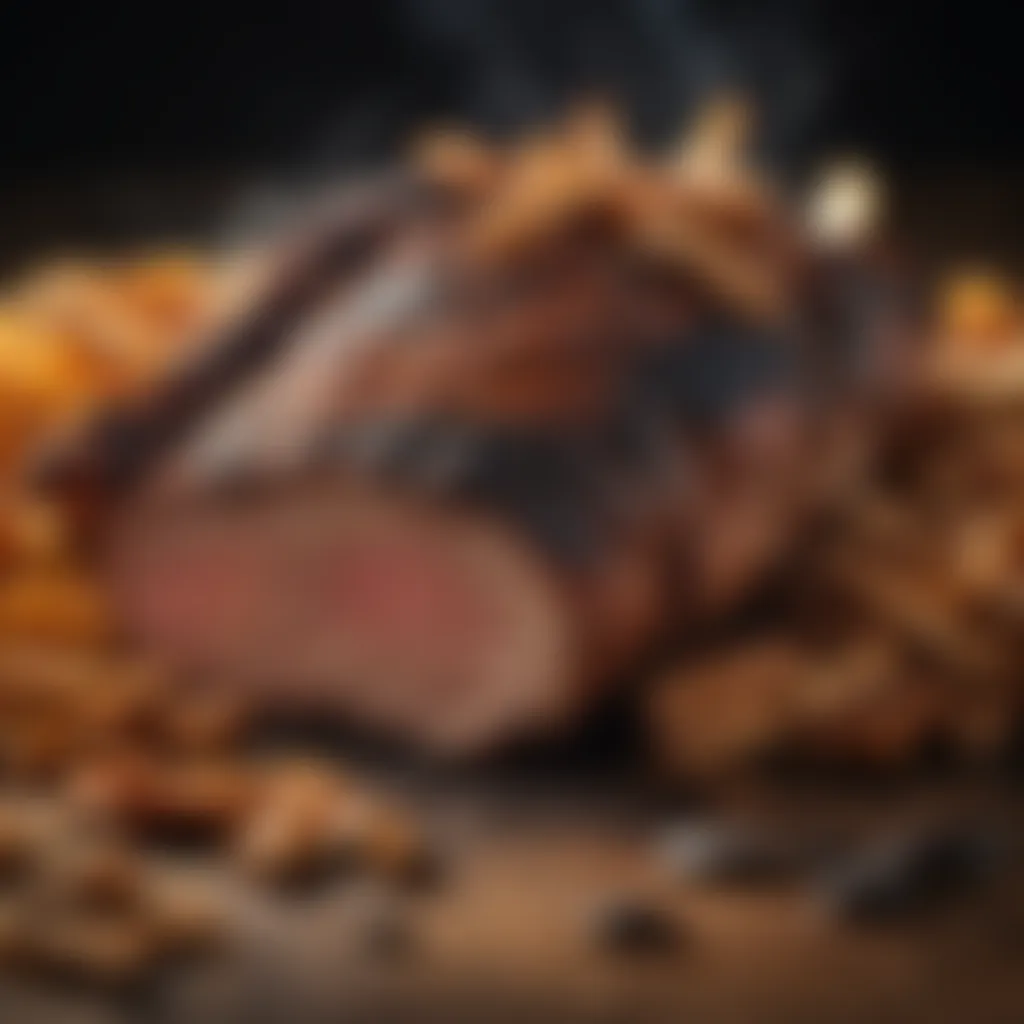
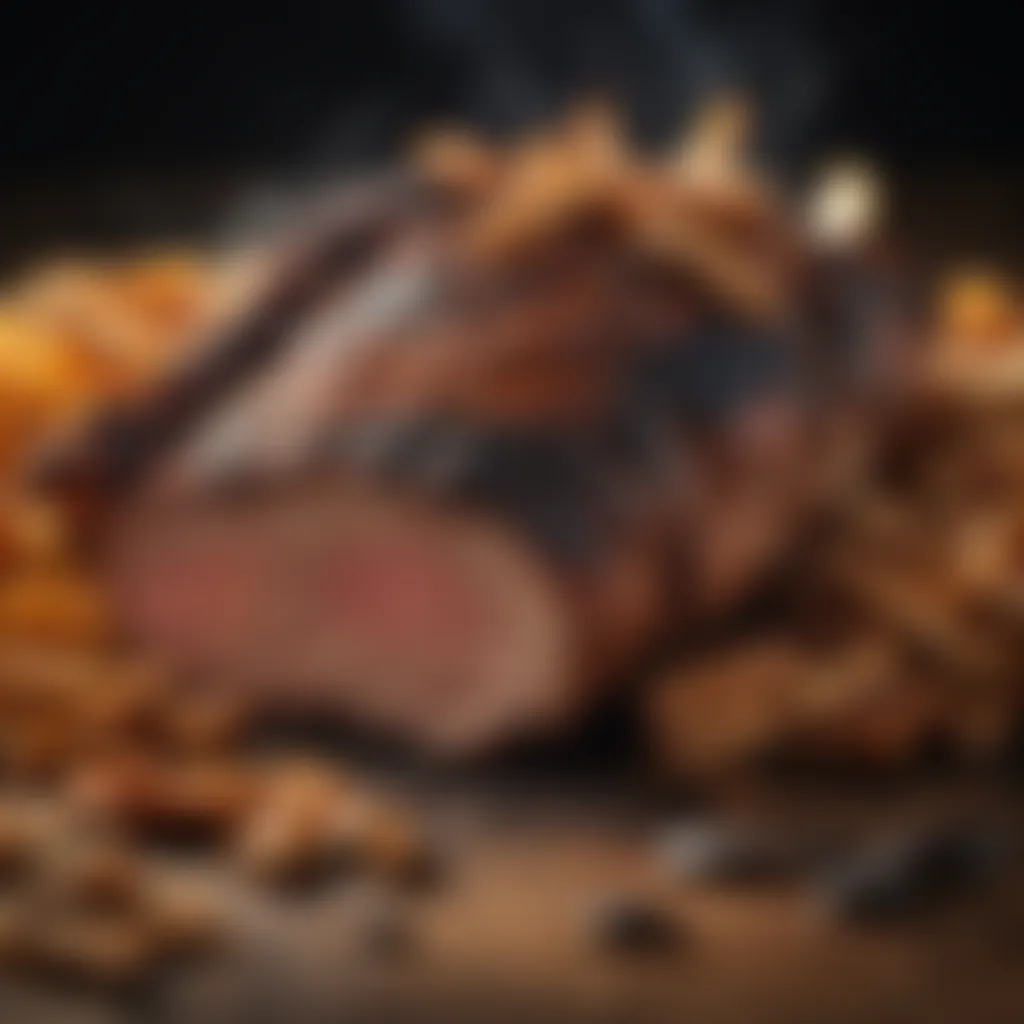
"In the art of smoking brisket, the techniques of flavor infusing, whether brining, injecting, or rubbing, are what set apart the mundane from the magnificent."
By implementing these techniques, you’re setting yourself up for a brisket that not only tastes incredible but also brings joy to those who partake in the meal.
Cooking Times and Timing
When it comes to smoked brisket, the age-old saying, "good things come to those who wait," rings especially true. Cooking times and timing are not just numbers to keep track of; they play a critical role in transforming a hunk of meat into a tender, flavorful masterpiece. Understanding how long to cook your brisket and when to do certain tasks can significantly affect the final outcome of your culinary endeavor.
Calculating Cooking Time
Getting the timing right starts with knowing how to calculate the cooking time for your brisket. On average, you can expect to spend about 1.5 to 2 hours of smoking time per pound of meat when using a 225°F to 250°F temperature range. This can change based on factors like the thickness of the meat, the type of smoker, and even the weather conditions.
- Weight Matters: A brisket weighing around 10 pounds might take anywhere from 15 to 20 hours to cook fully.
- Internal Temperature Goals: The ideal internal temperature for brisket generally hovers around 195°F to 205°F to ensure it reaches that pull-apart tenderness.
- Use a Meat Thermometer: Investing in a reliable meat thermometer is crucial in obtaining accurate results. It’s likely a wise decision that could save your entire brisket from being over or undercooked.
Remember, these numbers are just guides. Factors such as your cooking method, the brisket’s marbling, and even how long it was refrigerated before you started smoking can influence your timings. Keeping a close eye and making adjustments along the way is key.
The Importance of Patience
In the culinary game, patience is more than a virtue; it's a necessity. Rushing the cooking process can turn your brisket into a chewy disaster, while giving it the time it needs allows for magical transformations to occur.
- Collagen Breakdown: Brisket is tough due to the muscle fibers and collagen it contains. When cooked slowly, the heat helps break down those fibers, and that’s where the magic happens!
- Resting Time: After you pull your brisket off the smoker, it's crucial to let it rest for at least an hour. This allows the juices to redistribute throughout the meat.
- Enjoying the Flavor: Slow cooking allows for a deep infusion of smoke flavor, blending beautifully with any rubs or marinades you’ve applied. There’s no rushing that!
In short, timing in brisket smoking isn't just about keeping track of the clock; it's about achieving a juicy, tender, and flavorful result that you can showcase at any gathering.
Patience isn’t only a skill in the kitchen; it helps hone one’s craft and produces rewards that no pre-cooked meal could ever offer. Enjoy the process, and the end result will surely reflect your dedication.
Resting and Slicing
When it comes to preparing smoked brisket, two often overlooked but crucial steps are resting the meat and slicing it properly. These processes can make or break your culinary masterpiece. A brisket that has been treated with care during this phase will present flavors and textures that are simply unmatched. Let's jump into the details.
The Resting Period
After hours of slow smoking, your brisket is finally cooked to perfection. But it’s not time to dive in just yet. The resting period is a critical component often skipped by eager cooks. Allowing the brisket to rest for a proper amount of time—generally between 30 minutes to 2 hours, depending on size—serves several important functions.
First, it helps to redistribute the juices that have been pushed toward the center during cooking. When you cut into a brisket straight off the smoker, those flavorful juices will spill out onto the cutting board instead of remaining in the meat. By letting it rest, you ensure that each bite remains succulent and moist.
Consider this: If you slice too soon, you might as well be inviting your guests to a dry meat fest. The resting also allows the fibers to relax, which leads to a more tender final product. Think about it as allowing a song to resolve before delivering the final note.
It's also essential to cover the brisket loosely with foil or butcher paper while resting. This method traps some heat without causing the meat to steam and lose its desired crispy bark.
Slicing Techniques
Now that your brisket has had its time to shine post-cooking, it’s slicing time. But be warned—how you slice it matters just as much as how you cooked it. The right slicing technique can enhance the experience of enjoying that smoked brisket, allowing the flavors to blossom in every bite.
The first step is identifying the grain of the meat. Brisket has two distinct muscle groups, and each has its own grain direction. Generally, you want to slice against the grain, which means cutting perpendicular to the long lines you see on the meat. This prevents those unwieldy, chewy pieces that can lead to a less-than-pleasant dining experience.
Here's a simple breakdown of the slicing process:
- Use a sharp knife: A dull blade can tear the meat rather than providing a clean cut. This step is non-negotiable.
- Slice thick or thin: Depending on your preference and the occasion, make slices that are about a quarter of an inch thick, or go thinner for sandwiches.
- Cut the point and flat separately: Remember, the point (the thicker part) and the flat (the leaner part) have different textures, so treat them accordingly.
- Serve immediately: Once sliced, folks should get to enjoy it right away. Any lingering can cool off the beautiful warmth and texture you worked so hard to achieve.
"The art of slicing is as important as the art of cooking itself. Respect the cut!"
In closing, don’t underestimate the power of resting and the finesse of slicing. These steps can elevate your brisket from merely good to utterly unforgettable. Taking your time here shows true commitment to the craft of smoked brisket, and it’ll show in every delicious bite.
Pairing with Side Dishes
When it comes to a beautifully smoked brisket, the magic doesn't just lie within the tender, flavorful slices alone. The right side dishes can elevate the experience, transforming a good meal into a feast fit for any occasion. Pairing with side dishes is more than an afterthought; it’s a crucial component that complements the brisket, enhancing flavors and textures.
A thoughtfully chosen side can either balance out the rich, smoky notes of the brisket or add an unexpected twist that surprises the palate. Especially for someone who enjoys hosting friends or family, having a repertoire of complementary sides can impress your guests and create a harmonious dining experience.
Traditional Accompaniments
Going the classic route often brings satisfaction to the masses. Traditional accompaniments have been tried and tested through the ages, making them comfortable and familiar. Consider these options:
- Coleslaw: The crunchy, tangy elements of coleslaw provide a fresh contrast to the smoky richness of brisket.
- Baked Beans: The sweet and slightly smoky flavor of baked beans pairs well with the meat, making it a classic choice in many barbecue settings.
- Cornbread: A slice of warm, buttery cornbread can soak up juices from the brisket, rounding out the meal with hearty comfort.
- Pickles: The sharpness of pickles can cut through the richness of the meat, offering balance and a refreshing bite.
These sides don’t just complement the brisket; they enhance the overall experience, giving your meal additional dimension. When serving, arrange them in a way that encourages sharing and allows diners to mix and match flavors.
Innovative Pairings
If you're looking to impress or simply want to try something different, innovative pairings can transform the standard brisket meal into an exciting adventure for the taste buds. By stepping outside the box, you can introduce new flavors that may surprise and delight. Consider these fresh ideas:
- Roasted Brussels Sprouts with Bacon: The slight bitterness of Brussels sprouts, when roasted to perfection and paired with crispy bacon, adds depth to your meal.
- Quinoa Salad: A light quinoa salad with diced vegetables and a zesty dressing offers a healthy counterbalance to the rich brisket.
- Sweet Potato Fries: The sweetness of the fries contrasts beautifully with the savory brisket, bringing an enjoyable play of flavors.
- Asian Slaw: A slaw made with cabbage, carrots, and a sesame dressing introduces an exotic twist that complements the smoky flavors without overpowering them.
Remember, the goal is to create a well-rounded plate, where the sides work in harmony with the brisket. A little creativity in your side dish selection can ultimately lead to memorable meals that keep family and friends coming back for more.
"Great meals are a symphony of flavors, where every note matters, and pairing is key to achieving that perfect harmony."
By considering both traditional and innovative options, you'll not only please your palate but also create an inviting atmosphere at your table.
Common Mistakes and How to Avoid Them
When delving into the culinary art of smoked brisket, it’s easy to fall into a few common pitfalls. Understanding these mistakes can save both time and resources, making it crucial for anyone seeking to achieve that perfect, mouthwatering brisket. This section aims to illuminate prevalent missteps, while also guiding in the corrective measures that can help ensure your brisket turns out delightfully tasty.
Identifying Missteps
Before we can fix any errors, it’s important to know what those errors are.
- Under-seasoning: Often, people shy away from using too much seasoning, fearing they might overpower the meat. But brisket is a hefty cut that can handle strong flavors. Skimping on the rub can lead to bland results.
- Cooking at unpredictable temperatures: This can derail your entire cooking process. It’s tempting to crank up the heat to speed things along, but brisket rewards low and slow methods. Having an unstable temperature can lead to uneven cooking.
- Not letting the meat rest: Some folks can’t wait to dig in as soon as the brisket is off the smoker. However, slicing too soon often results in dry meat. Resting allows the juices to redistribute.
- Choosing poor-quality wood: The quality of your smoked wood can have a significant impact on flavor. Using wood from fruit trees like cherry or apple can bring a sweetness that complements the brisket, while using treated woods can introduce unwanted flavors.
- Ignoring the grain: Cutting against the grain is essential for bite-sized pieces that are tender. Cutting with the grain can lead to a chewier, less enjoyable eating experience.
Corrective Measures
Now that we have a handle on what might go wrong, let’s explore how to avoid these blunders and achieve brisket perfection:
- Over-season generously: Use a robust rub with salt, black pepper, garlic, and spices of your liking. Don’t be afraid to use a decent amount. Remember, a well-seasoned brisket is a happy brisket.
- Invest in a reliable thermometer: Monitor your cooking temperature consistently. Aim for a range between 225°F and 250°F. This steadiness allows the internal juices to develop and the smoke to envelop the meat properly.
- Prioritize resting time: Once you take it off the heat, let your brisket rest for at least one hour. Loosely wrap it in aluminum foil and let it sit. This is time well spent, as it transforms a decent brisket into one that’s melt-in-your-mouth tender.
- Use quality smoking wood: Source your wood carefully. Look for clean, untreated wood that adds flavor rather than detracts from it. A mix of wood types can add unexpected layers of taste.
- Practice perfect slicing: With a good knife, slice the brisket against the grain. This simple trick can make a world of difference in the tenderness of each bite.
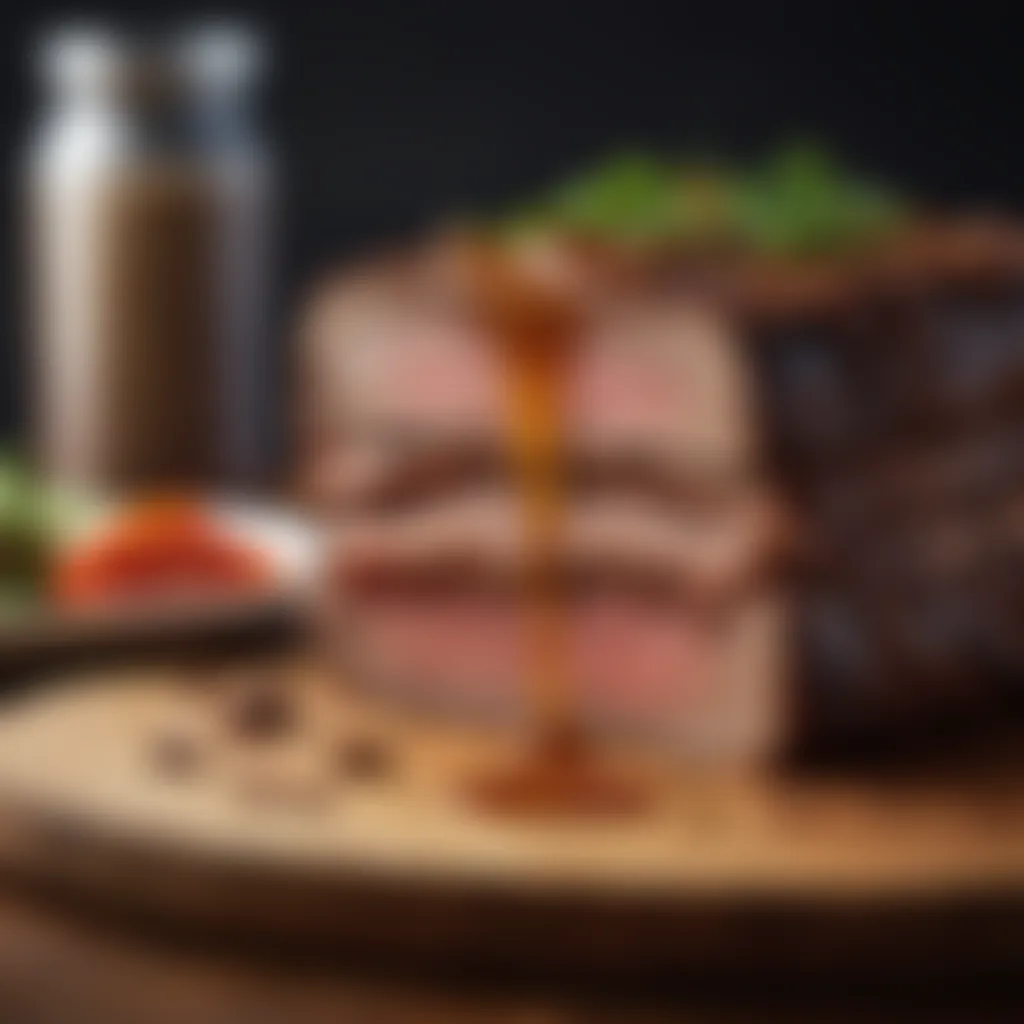
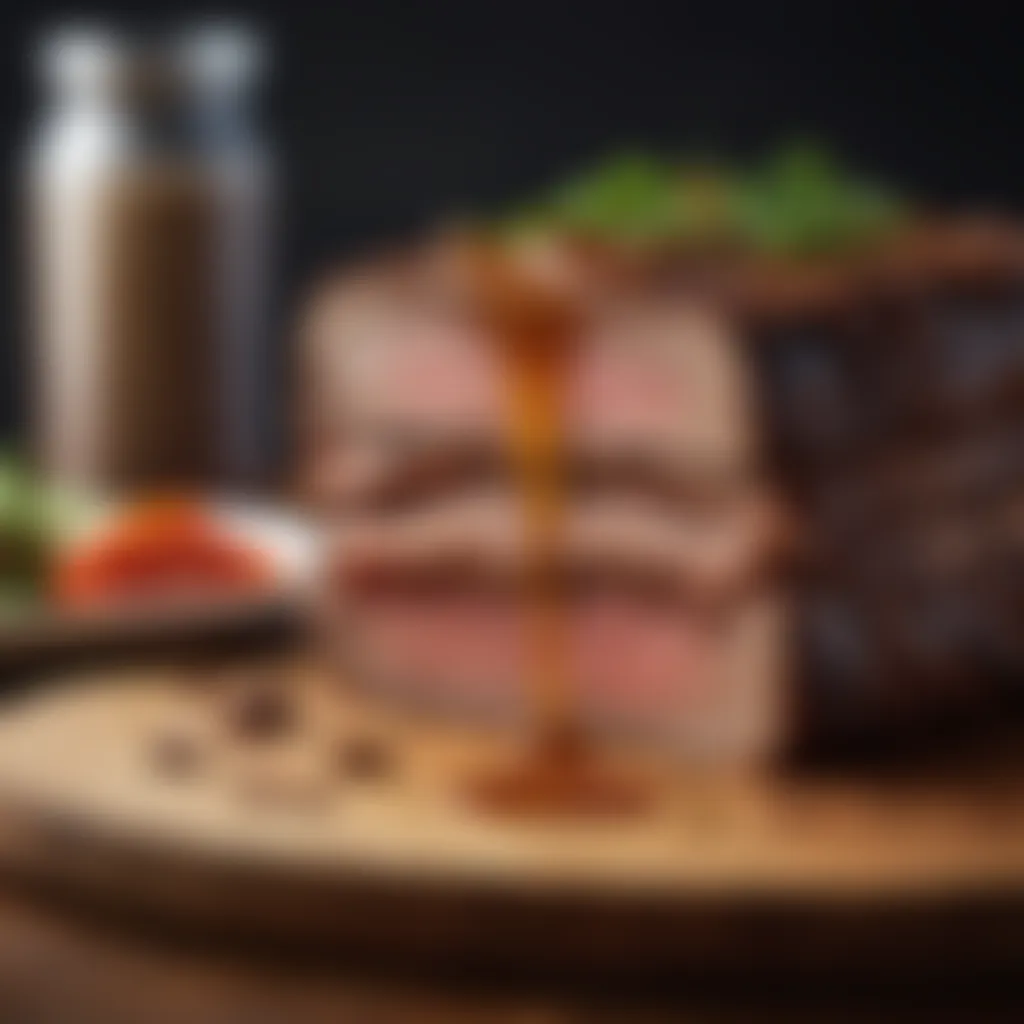
"In smoking, as in life, it’s not just about the finish, but how you get there. Mind the details."
In summary, by recognizing these errors and understanding the fixes, you stand a much better chance of crafting not just any brisket, but a divine one. As with anything, practice leads to mastery. Don’t shy away from experimenting; the kitchen is your canvas!
While brisket is a traditional dish with deep roots in many culinary cultures, the mastery of smoking it is truly an evolving experience, unique to each cook.
The Science Behind Smoking
In the realm of smoked brisket, it’s not just about the skill of cooking; it’s a mesmerizing dance between science and cuisine. Understanding the science behind smoking sets a robust foundation for any aspiring pitmaster. This knowledge lends itself to more than just enhanced flavor—it's about fostering a deeper connection with the art of barbecue. By grasping how chemicals engage in the cooking process, one can turn a humble brisket into a culinary masterpiece.
A few critical elements take center stage in this scientific saga: chemical reactions, moisture retention, and smoke's intrinsic qualities. The benefits of understanding these elements stretch far beyond mere aesthetics—think of it as arming yourself with the knowledge to consistently produce tender, flavorful meat that might just leave your friends envious.
Chemical Reactions in Smoking
When we smoke brisket, a series of transformations occur that are deeply rooted in chemistry. Among these, the Maillard reaction plays a pivotal role. This reaction happens when proteins and sugars start breaking down at high temperatures, forming a rich array of flavor compounds and browning the exterior of the meat. Swapping a dry brisket for one that participates in this reaction is akin to trading a pebble for a diamond.
Furthermore, the heat from the smoker causes other complex reactions, such as caramelization. This adds a sweet, nutty flavor profile that complements the savory notes brought forth by the Maillard reaction. It’s almost like building layers of flavor—each reaction contributing to a mouthful of magic.
Don't forget the smoke itself. When wood burns, it releases certain chemicals such as phenols and carbonyls that weave their own stories into the brisket. These compounds latch onto the meat, infusing it with deep, smokey flavors that cannot be replicated through any traditional cooking method. It's important to note that the choice of wood can alter these chemical interactions. For example, hickory may introduce a stronger flavor than applewood, making one fit better for your personal taste.
The Role of Smoke in Flavor Development
Smoke is much more than just a means of cooking; it acts as a flavor enhancer, elevating simple ingredients into something extraordinary. One of the fascinating elements is how smoke adheres to the surface of the brisket. This process called adsorption captures the flavor compounds and water vapor, enhancing the overall juiciness of the final product.
As the brisket cooks, it undergoes a process called "smoke ring" formation. This phenomenon occurs when gases emitted from burning wood penetrate the meat's surface, providing visual appeal and a deeper, richer flavor. The smoke ring, often coveted by grillers, adds a layer of authenticity to your smoked creation.
Moreover, the smoke's aromatic compounds are known to activate receptors in our brain associated with flavors we adore. It’s almost magical how these elements can evoke memories and emotions, making every feasting moment more significant. Beyond that, understanding the balance of smoke is critical. Too much, and the brisket can turn bitter; too little, and you’re left wishing for more. It’s like crafting a perfect melody—the right notes combined in harmony feed the soul and congregate friends and family around the table.
"Good meat is the key to barbecue, but understanding the science behind smoking transforms it into a heavenly experience."
As you dive deeper into the science behind smoking, realizing that it’s not just rote memorization but rather an enriched symphony of reactions and flavors may excite an inner curiosity in you. Grilling becomes more than a simple cooking method; it morphs into a dynamic opportunity to connect with your culinary roots and elevate your brisket-making game to new heights.
Culinary Traditions of Brisket
Exploring culinary traditions surrounding brisket opens a window to its historical and cultural roots that stretch across many regions. This foundational knowledge helps any cook appreciate the dish beyond mere cooking techniques, recognizing its significance in gatherings, feasts, and everyday family meals. Every family recipe tells a story, each part of the cooking process steeped in memories, local preferences, and a dash of cultural identity.
Regional Variations
Brisket isn’t just a one-size-fits-all meat; it wears many hats depending on where you hail from. For instance, in Texas, smoked brisket is often seasoned with a simple rub of salt and pepper, focusing on the meat’s natural qualities and the smoke's flavor. On the other hand, Jewish delis often serve brisket braised in a savory broth, accompanied by sweet and tangy ingredients, highlighting a contrast that sweetening brings to the rich profile of the meat.
- Texas Style: The pride of Texas barbecue, heavily smoked, accompanied by a heavy dose of spices and served with pickles or onions.
- Jewish Tradition: Typically slow-cooked in a pot with vegetables, leading to a tender outcome ideal for sandwiches or served with sides like potato kugel.
- Korean BBQ: Here, brisket is sliced thin and cooked on a grill, often marinated in a mixture of soy sauce, sugar, and sesame oil, showcasing a fusion of flavors.
These adaptations not only showcase regional ingredients but also reflect how local cultures interact with cooking traditions.
Brisket in International Cuisine
The versatility of brisket transcends borders, becoming a beloved ingredient in various culinary traditions worldwide. In Brazil, brisket is commonly used for a national dish called churrasco, where it's grilled on skewers, celebrating the joys of outdoor cooking. Alternatively, in the Philippines, brisket is a key component of kare-kare, a rich and savory stew that pairs the meat with a thick peanut sauce, emblematic of the country’s bold flavors.
This global approach to brisket allows home cooks to explore different flavor profiles and culinary techniques. It's a melting pot of cooking styles that enriches the dining experience:
- Brazilian Churrasco: A focus on grilling with simple seasonings, often presented at vibrant gatherings.
- Filipino Kare-Kare: A hearty stew that embraces unique flavors and techniques, from braising to thickening sauces using ground peanuts.
- British Pot Roast: Here, brisket is often cooked with root vegetables, reflecting the hearty, traditional Sunday roast.
"Food is not just nutritional—it's a medium through which we express who we are and where we come from."
Understanding these traditions can elevate one's cooking and appreciation for brisket, encouraging experimentation and adaptation in your own kitchen. Having insight into these regional and international traditions not only makes the cooking process richer but also connects every home chef with the tapestry woven by different cultures throughout history.
Sustainability in Meat Selection
Sustainability in meat selection is increasingly gaining prominence in culinary discussions, especially when it comes to a beloved dish like smoked brisket. Selecting sustainable meat isn't just a trend; it represents a shift towards a more conscious and responsible approach to our food choices. This article emphasizes that the way we source our brisket can significantly impact both the environment and the local economies, ultimately enriching our culinary practices.
Ethical Sourcing
When it comes to sourcing brisket ethically, the focus lies predominantly on animal welfare and fair farming practices. The demand for grass-fed and pasture-raised beef has risen significantly. Such sourcing practices prioritize the health of the animals and the ecosystems they inhabit. They tend to yield more flavorful brisket, too—something every home cook desires.
Consider this: when meat is raised without the use of antibiotics or hormones, not only does the quality improve, but it also lessens the risk of antibiotic resistance, a growing concern in today's society. This doesn't merely benefit our health; it also contributes to the overall well-being of the planet.
Ethical sourcing often means supporting local farmers or sustainable beef programs that produce meat in an environmentally friendly way. It's a win-win for consumers who want to enjoy delicious brisket while also contributes positively to local economies and diminishing the carbon footprint of the meat industry.
Environmental Considerations
From an environmental perspective, the impact of livestock farming on climate change is undeniable. The production of meat, especially from industrialized operations, can be devastating, leading to deforestation, high greenhouse gas emissions, and depletion of water resources.
By choosing sustainably sourced meat, we begin to turn the tide. Grass-fed cattle generally require less grain feed, thereby reducing the need for harmful agricultural practices. Moreover, sustainably managed pastures tend to be better for biodiversity, promoting a healthier ecosystem.
Furthermore, engaging with local farmers who practice rotational grazing can greatly improve soil health. This is vital, as healthier soils can sequester more carbon, helping to combat climate change. Simple decisions made at the local butchers or farmers markets about the origin of your brisket can create a ripple effect that extends far beyond our dinner plates.
"A small change in how we source our food can lead to larger impacts on the world."
Culmination and Reflection
Crafting a divine smoked brisket involves more than just the basic steps of seasoning, smoking, and serving. It’s a process that dives deep into the heart of culinary tradition and personal expression. Conclusion and Reflection serves as a pivotal point of our journey through this intricate art. This part encourages you to contemplate the skills acquired, the lessons learned, and how they tie into your unique cooking style.
Reflecting on your brisket journey allows you to appreciate the nuances behind each technique you've applied. It sharpens your awareness of quality ingredient selection, instills a deeper understanding of flavor profiles, and highlights the value of patience in the cooking process. Each of these elements is vital, and they come together to elevate your experience from mere cooking to mastering a cherished craft.
Being aware of what went well or what could improve on your next attempt creates a framework for growth. This approach transforms every cooking session into an exploration, rather than just a repetitive task. It’s in these reflections that the soul of the smoked brisket is found, where recipes turn into traditions, and each bite tells a story.
"Cooking is like love. It should be entered into with abandon or not at all."
— Julia Child
In this culinary adventure, consider how every element of your method resonates with your identity as a cook. The joy of sharing your smoked brisket creation with family or friends amplifies this connection. When you take a bite of that tender, smoky goodness, recall the journey it took to get there. It’s not just about satisfying hunger; it’s about nurturing relationships and creating memories.
As we wrap up this exploration, the beauty lies in knowing that with each brisket you smoke, you carve out a piece of tradition that is distinctly yours.
Summary of Key Points
In summary, meticulous attention to the following points can lead to an extraordinary smoked brisket:
- Understanding the Cut: Knowing the anatomy and best cuts of brisket helps in achieving the desired tenderness and flavor.
- Ingredient Quality: Sourcing high-quality meat and making thoughtful choices about marinades and rubs is paramount.
- Temperature Control: Mastery of temperature management ensures a perfectly smoked brisket, retaining moisture and enhancing flavor.
- Technique Refinement: Regular reflection on cooking techniques fosters continual improvement and personal style.
Final Thoughts on Crafting Smoked Brisket
To conclude, the mastery of crafting smoked brisket is a rewarding pursuit that merges art and science. It allows for creativity through flavor combinations, traditional techniques, and personal touches. Whether you are a novice or have some experience under your belt, embracing the learning process is crucial. Each attempt at brisket prepares you for the next, gradually honing your skills and deepening your appreciation for smoked meats.
Remember, it's not simply about cooking; it's about enjoying the journey and savoring the flavors forged through patience and passion. As you carve into your next brisket, carry forth the lessons, the love, and the traditions that make your cooking truly special.







